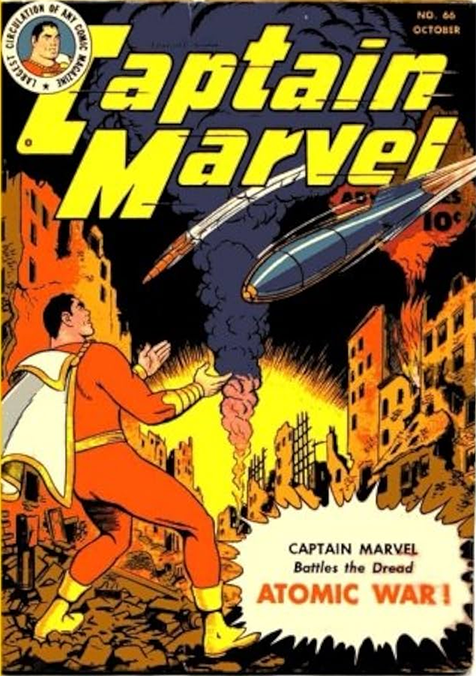Long ago, before the internet was the gigantic place it was today, I heard rumors about this issue being a thing that existed but I couldn’t actually find out much of anything about it. I love the Golden Age Captain Marvel despite the bad from that period in history; while it does mean cringing through a painful amount of period racism (most especially early on) and some levels of sexism, there frankly wasn’t a single major comic book character back then who didn’t have some of both of those things baked in. And for the most part, the ugly parts did tone down over time; it really was most prevalent early on.
I tend to skip the stories with racist depictions entirely because I don’t feel that even the era is an excuse for them — no amounts of racism or sexism or other forms of bigotry are excusable, and coming across it feels like a slap in the face every time — but I do want to say there’s still good in these books worth acknowledging outside of that.
Don’t worry, I do have a point to this ramble, just bear with me.
Back then, I’d read a lot of meta about the good Captain and Billy and the company they’d come from; the story of the lawsuit that ultimately killed them, only for an attempted resurrection in the 70s by the company that pulled the trigger. This is all common knowledge now for anyone who really follows the character; I won’t rehash it yet again, I’ll just say that DC has never entirely figured out how to handle Cap or Billy since the trigger was pulled on them in ‘53. Certainly not when they tried to revive them in the 70s, and not since, either.
So, I’d heard rumors about CMA #66, but despite repeated attempts to find out more about it because holy shit??, I was thwarted at every turn. I didn’t know at that point that it had been reprinted in DC's Greatest Imaginary Stories Ever Told in 2005, ‘cause like I said, the internet was a much smaller place and Captain Marvel stuff was extensive but also thin on the ground.
A lot of what DC does wrong — in my opinion — is mistake what made the Marvel Family so appealing in the first place, even today, and then fail to genuinely take that into account for a modern audience. Instead of sitting down and looking at those old stories for what they are (and how good some of them really are!), they try to find what formula made Captain Marvel the best-selling superhero of the Golden Age and latch onto either the humor or the fact that Cap’s alter-ego was a boy, rather than a man.1
What they don’t seem to get is that there’s not a formula there in the first place. And that there never actually was.
But there’s always this fundamental misunderstanding of the appeal of these Golden Age stories. If you’ve read my ramble about Whiz #50, for example, you’ll realize it isn’t just a question of humor: That story’s funny as hell and somewhat at the expense of Captain Marvel himself, but I still love it more than any modern attempt at being funny with Cap.
As I say there:
… I love this one for its essential humanity. The hero got himself into this mess, he and Billy got him out of this mess, and stopping the criminals was actually just kind of a lucky stroke thrown in there.
But even though Cap got himself into this, the story never treats him like he’s stupid. It never treats him like he’s some kind of idiot. You’re laughing, but– not in a mean way.
(That’s part of my serious beef with the way modern writers write the core JLI, too, as individuals or as a team—
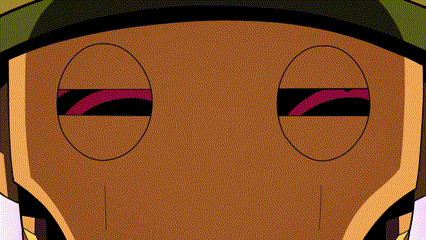
—which is the absolute inability to realize what made that book and those characters successful at that time and then write it in a way that updates it and yet retains that charm. Coincidentally, it’s a lot of the same thing they keep failing to get about Captain Marvel’s Golden Age success!)
What fundamentally worked about Captain Marvel and the Marvel Family, despite some genuinely silly and madcap concepts, was that the stories were good. They were tight. They didn’t instill drama where drama wasn’t needed in an attempt to be edgy. They didn’t leave anything important out, though, either. They did have their serious moments, and they ranged from slapstick comedy to straight-up action-adventure, but they were generally pretty structurally sound regardless of which genre they were crossing.
Most critically, they didn’t treat their protagonists like fools, so much as people you could laugh with and at and for. That you could love. Nor did they twist them all out of shape for the sake of a story: Instead, they told stories that could stand with and on the strong foundations of the characters themselves.
As you’ll see in this story specifically, Captain Marvel is Captain Marvel, completely regardless of circumstances. Some things about him are immutable and should be.
Notably, Billy Batson was competent. He was a smart kid with a job, brave and every bit as much a hero as his alter-ego. And Captain Marvel was competent. He was the most powerful hero in his universe and very rarely had that challenged. Neither of them were push-overs. Billy wasn’t really childish; he was a boy, but he was a boy who carried himself as a force to be reckoned with. And Cap wasn’t just Billy in a big, superpowered body: He was a grown man with a grown man’s personality.
But more than anything, they were incredibly human. You could tell a silly human story with them — like a superhero losing his suit because he went skinny-dipping! — and entertain the hell out of both adults and children without damaging their esteem in the eyes of the audience.
Bringing this back to CMA #66—
When you remember that, at the heart of them, Captain Marvel stories were human stories about human characters, suddenly it doesn’t seem impossible that Binder and Beck would tell this particular story. Because Captain Marvel stories were never only comedy.
With that in mind—
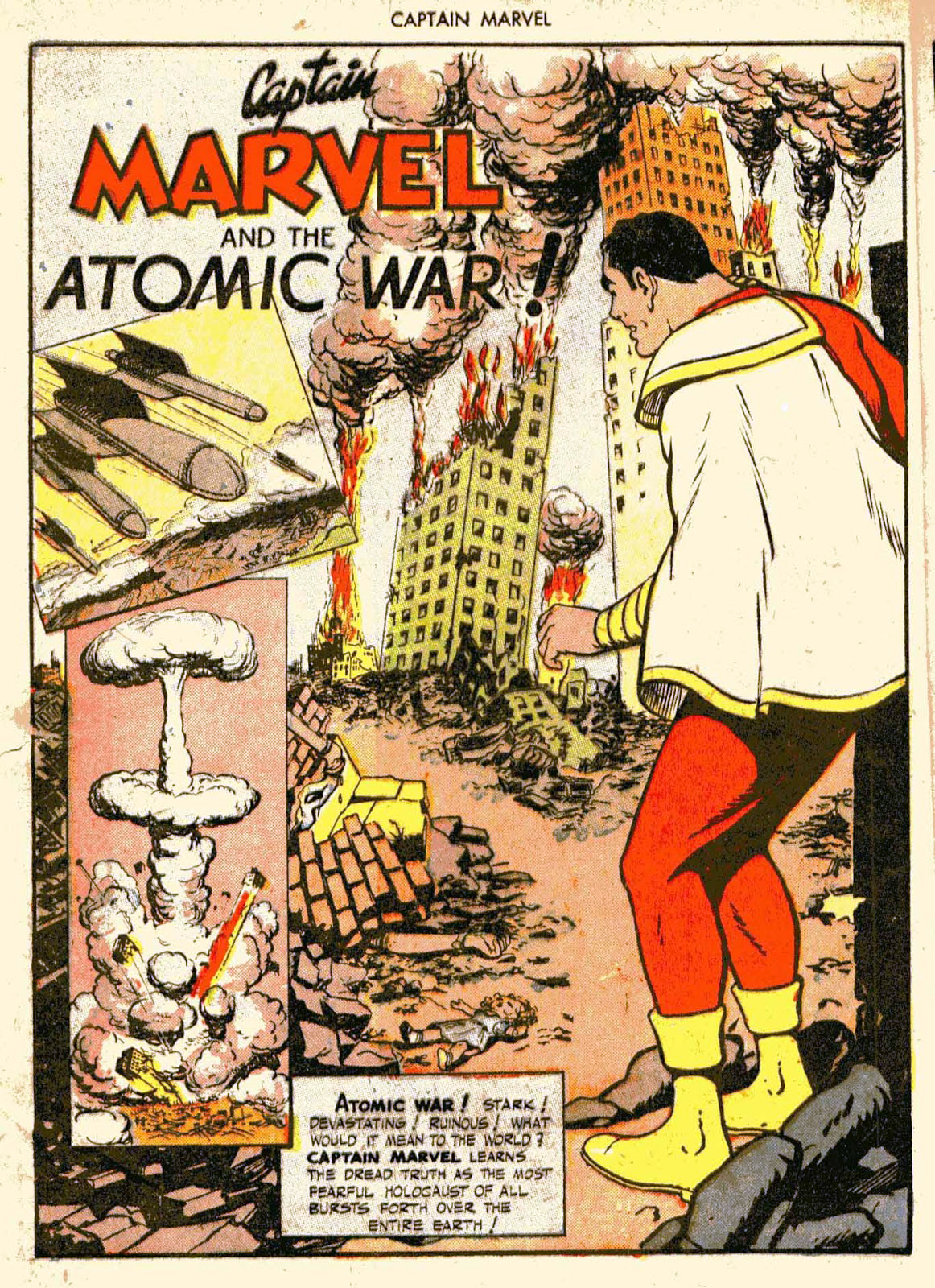
Stark really is the word for the art in this issue. Not in terms of bare, but in the severity of it. And I mean, seriously, look at it. We dropped the first atomic bomb on the city of Hiroshima on August 6th, 1945. Only a year later, you have the best selling superhero in the world starring in this story here.
From our clean-lined hero surrounded by debris and devastation to the doll in the foreground forcing a reckoning with the imagery, it wasn’t hard to gather what the opinions were behind the writing and art in this issue. I can’t even imagine what a surprise it really was, picking this one up from the newsstands, because while I maintain that it’s not actually out-of-character for Fawcett to print it, it’s still a shock to the system to really see it.
I also think it’s a pretty brave story to tell, too.
It opens with the same quick establishment as most stories do in this era. There’s no real wasted space.
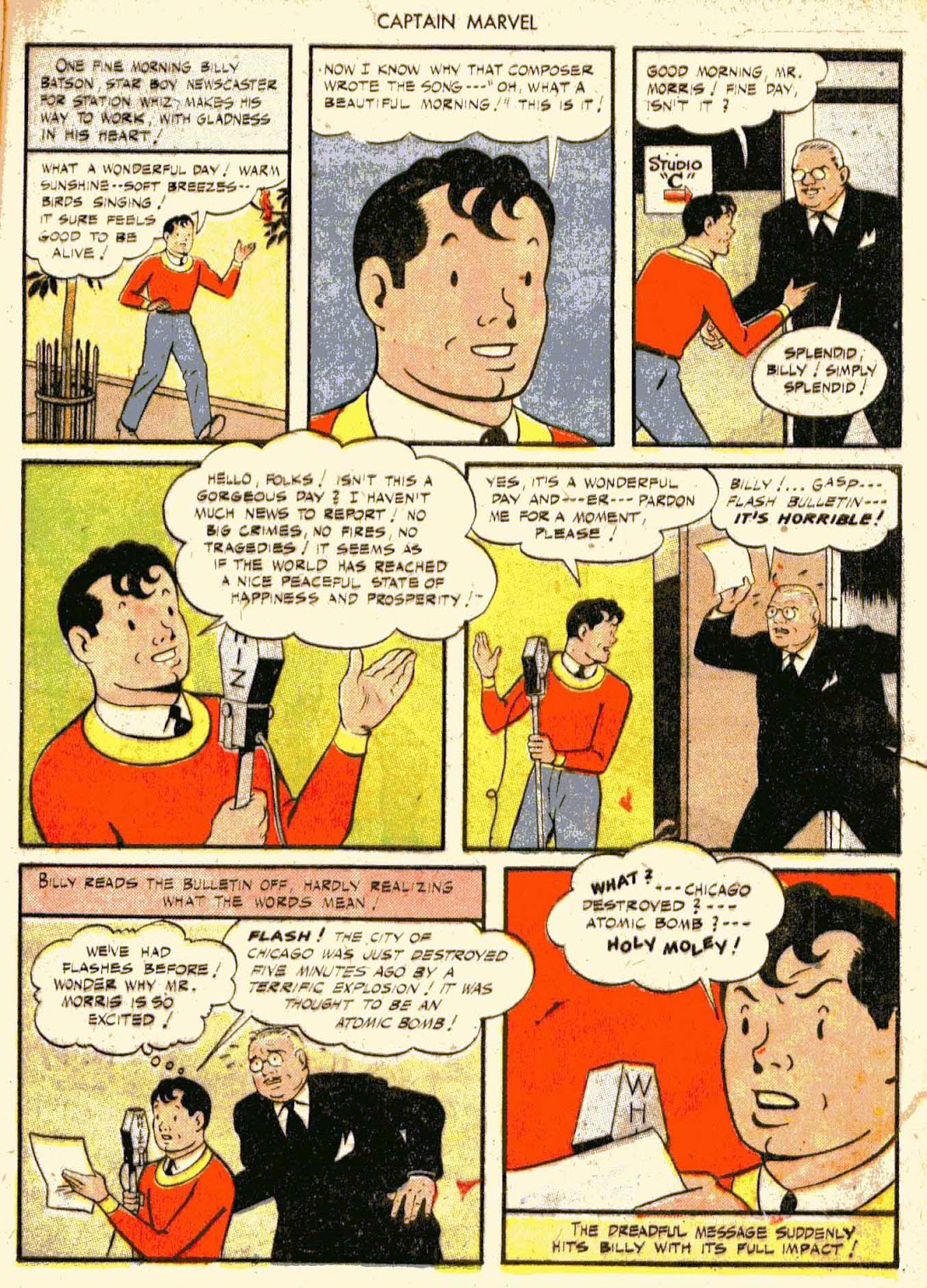
Binder makes sure we know what a beautiful day it is, both literally and socially, before immediately yanking the rug right out from under us. And suddenly, we’re not dealing with caterpillars with glasses or one of the Sivanas, but instead we’re looking right at something that people back then had to be terrified of. That many people are still terrified of now. The existence of it; of this thing that turned human beings into shadows on broken walls.
Years later, the Cuban Missile Crisis would scare the daylights out of people in the US, and with good reason. I can’t fathom what it must have been like in 1946, with this new horror unleashed on the world, and one that most people must not have understood fully just because it was still so new.
I mean— the Cold War is we define it is on the very edge of my living memory and even I knew how to be afraid of a nuclear war growing up.
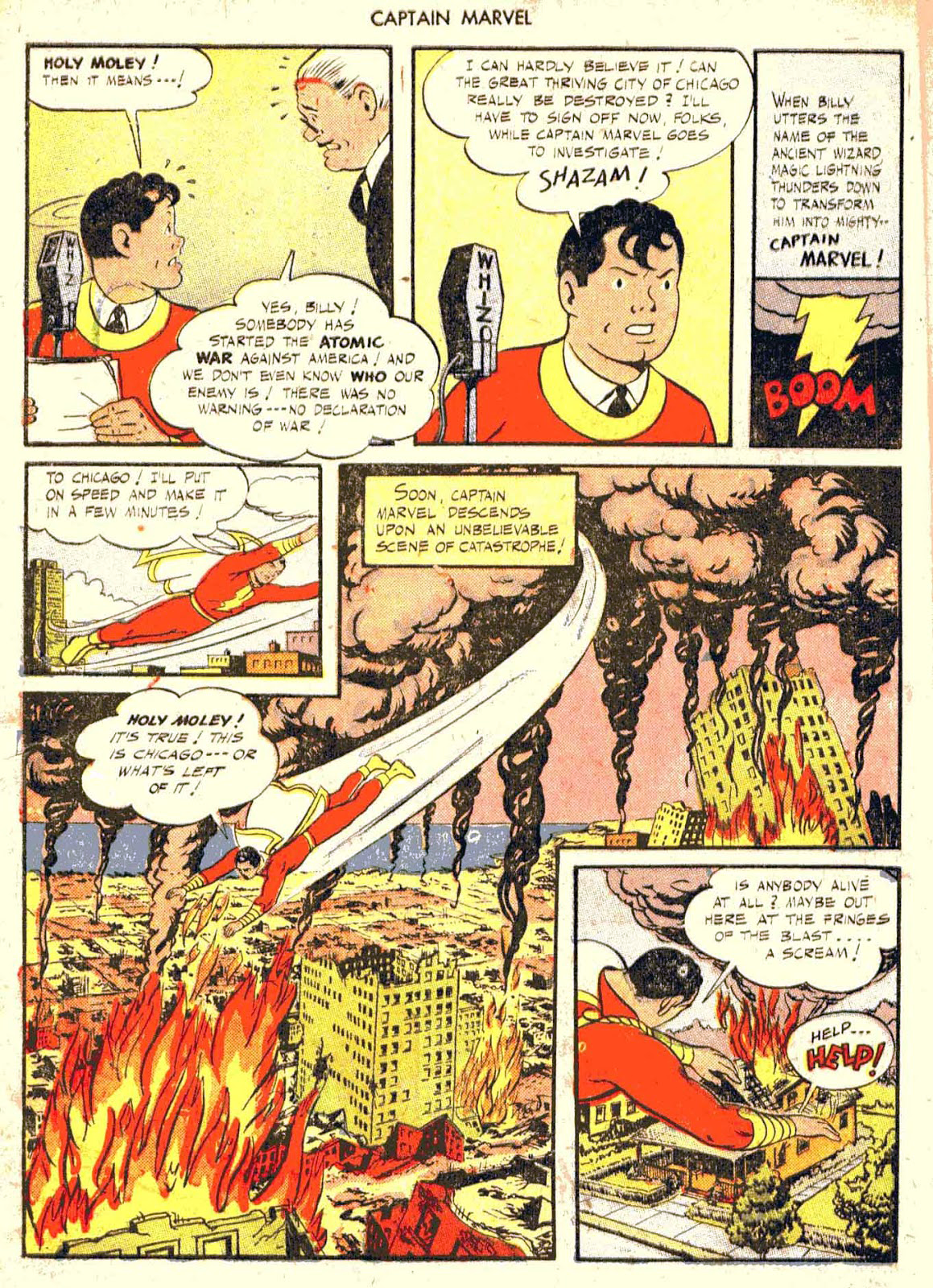
If you’re familiar with Cap’s books, you’ll be familiar with how this art differs from just about every other issue. Not to say the art is somehow simple or cartoonish in other issues; it’s not. But here is still something different, both in the art and in the coloring. People follow their models accurately for Cap and the characters, but the environmental depictions push hard on the absolute devastation.
(As a quick aside: C.C. Beck is listed as artist, but he actually had an entire stable of artists who worked under his name, so it’s fairly impossible to pick out what specifically would be his aside from Cap’s expressions.)
Tellingly, early on, Captain Marvel’s response isn’t to get angry. He doesn’t give into that until later on. But here, and through some heartbreaking stuff following, his response is despair. Anger would be understandable, too, but something about his grief strikes me as 1.) A very telling character trait and 2.) Achingly human. Remember what I said before about these stories?
There’s likewise no real mercy here, not for a moment:
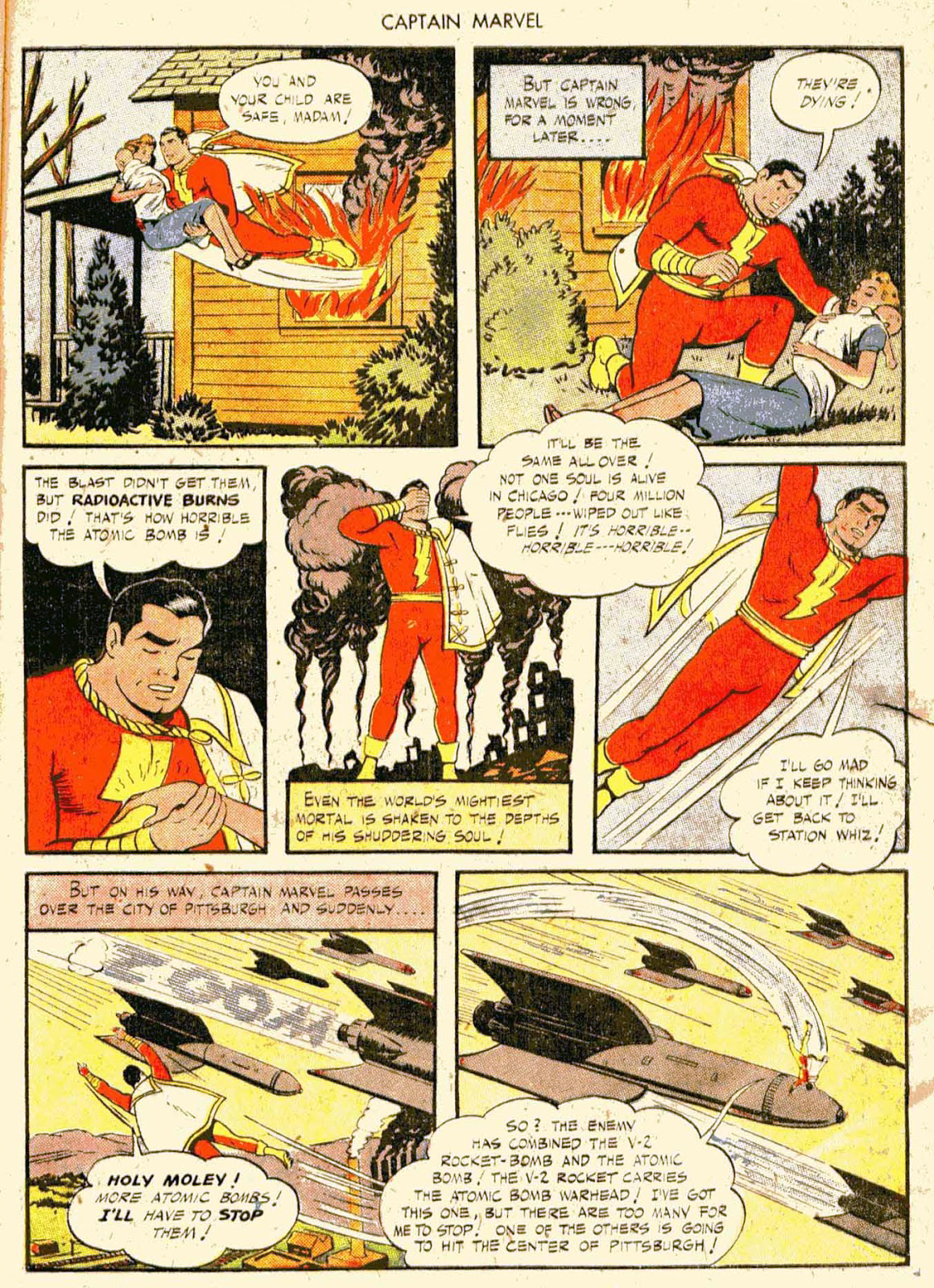
Cap saves a woman and a baby. Except— he doesn’t. They die right there. Depicting a dead infant is something you just don’t really see in comics often, I don’t think then and certainly not now; using that visual here, in this way, is just— so effective. And Cap standing up and just covering his eyes like that also is. Binder says it himself: shaken to the depths of his shuddering soul.
It’s hard to know what all to say in some part because these stories are exceptionally sharp in plotting and pacing; that’s not to say they’re automatically better than a story which has space for filler and quiet character beats, because they aren’t. But they serve their purpose in a different fashion. A lot of what I would say about them, they already say for themselves.
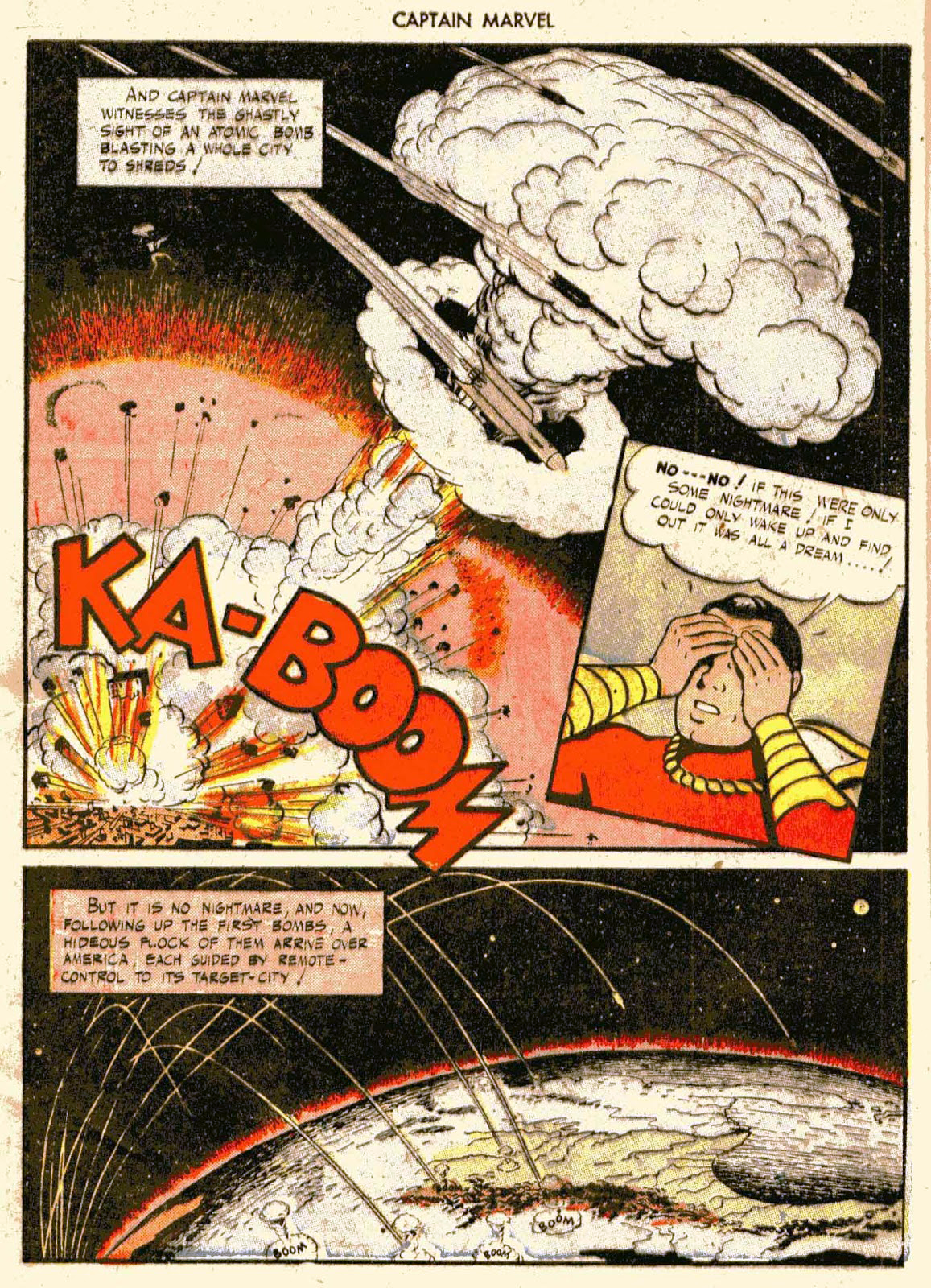
It’s (obviously) grim stuff: The depiction of the World’s Mightiest Mortal high above a world being swiftly reduced to burning devastation, largely helpless to do anything about it. That’s very much not typical for Cap, who again is the premier superhero in his universe; not much can beat him, which is why it’s usually Billy who gets targeted instead.
So it’s particularly effective as a story beat to show Cap’s tiny form high above the explosions and the brief cut of him just covering his eyes again, shell-shocked by the horror of it all.
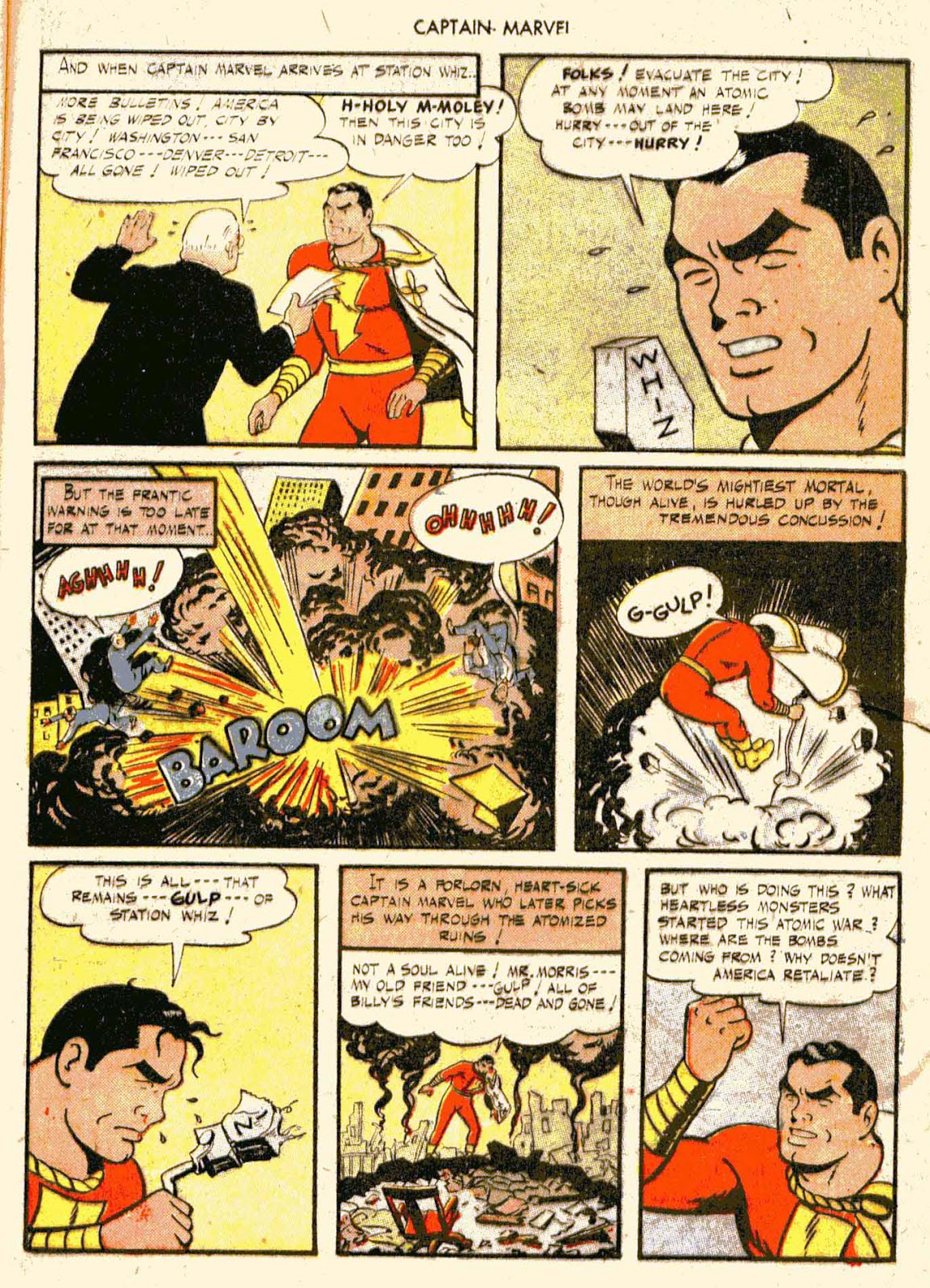
Again, cannot imagine what it woulda been like to read this one cold, with no prior knowledge as to how it ends. Because jeez, they just wiped out the entire secondary cast of the book, essentially, in one fell swoop. Unlike the prior pages, this one’s a little more ‘comic book’ in how its structured and depicted, though there’s still nothing funny about it.
Cap finally gets angry, though even he doesn’t quite know who he’s even supposed to be angry at yet. If it seems out of character that he asks why the nation isn’t retaliating and seems a little blood-thirsty (and boy, is that a weird sentence to type about him!), I do believe that was an intentional choice to have him act as a mouthpiece for the audience of the time, many or most of whom would probably ask the same question, provided they were alive to do it.
Particularly given the way the story plays out.
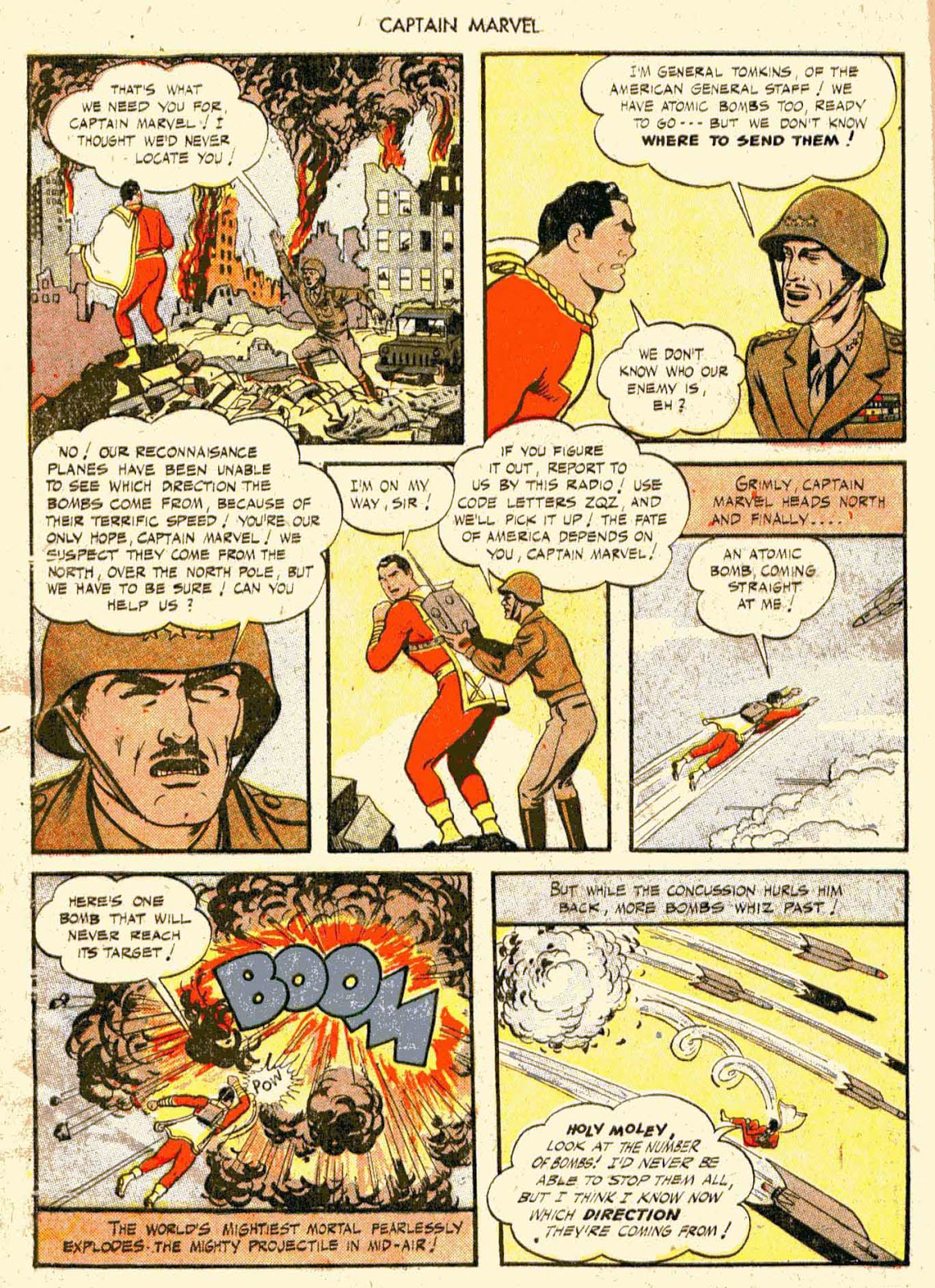
Cap gets dragged into the fray, as one might expect to happen if you were a superhero and the world was ending, with the military basically setting him up to be their own missile guidance system. Like I mentioned above, though, this seemingly uncharacteristic action on Cap’s part has a purpose, and because Otto Binder was a powerhouse of a writer, he could spin a complete tale inside a very limited number of pages.
A lot of people tend to view Binder’s work as being whimsical because a lot of it is. He not only had a huge hand in Captain Marvel’s success and created Mary Marvel, but he also brought a lot of what is now major scaffolding to the Superman mythos, too: His list of credits for DC include the creation or co-creation of Supergirl, Krypto, Brainiac, Bizarro and the Legion of Super Heroes, an absolutely huge number of brilliant additions that get regularly used today by all and sundry at DC. A lot of people forget that Superman could be a pretty grim guy — in fact, here’s an entertaining forum thread about his body count in the Golden Age — and so it wasn’t actually a bad thing that Binder brought some of the more lighthearted elements to Superman’s Silver Age, whatever you might think of its occasional silliness.
Another thing to note about Binder was that he was incredibly generous in giving credit to others he worked with. I’m always happy when I see credit being given back to him, too; as one writer analyzing another, there’s a lot to admire about his work.
Which is why, for all of the whimsy he’s known for, this particular story shows how diverse his abilities really were.
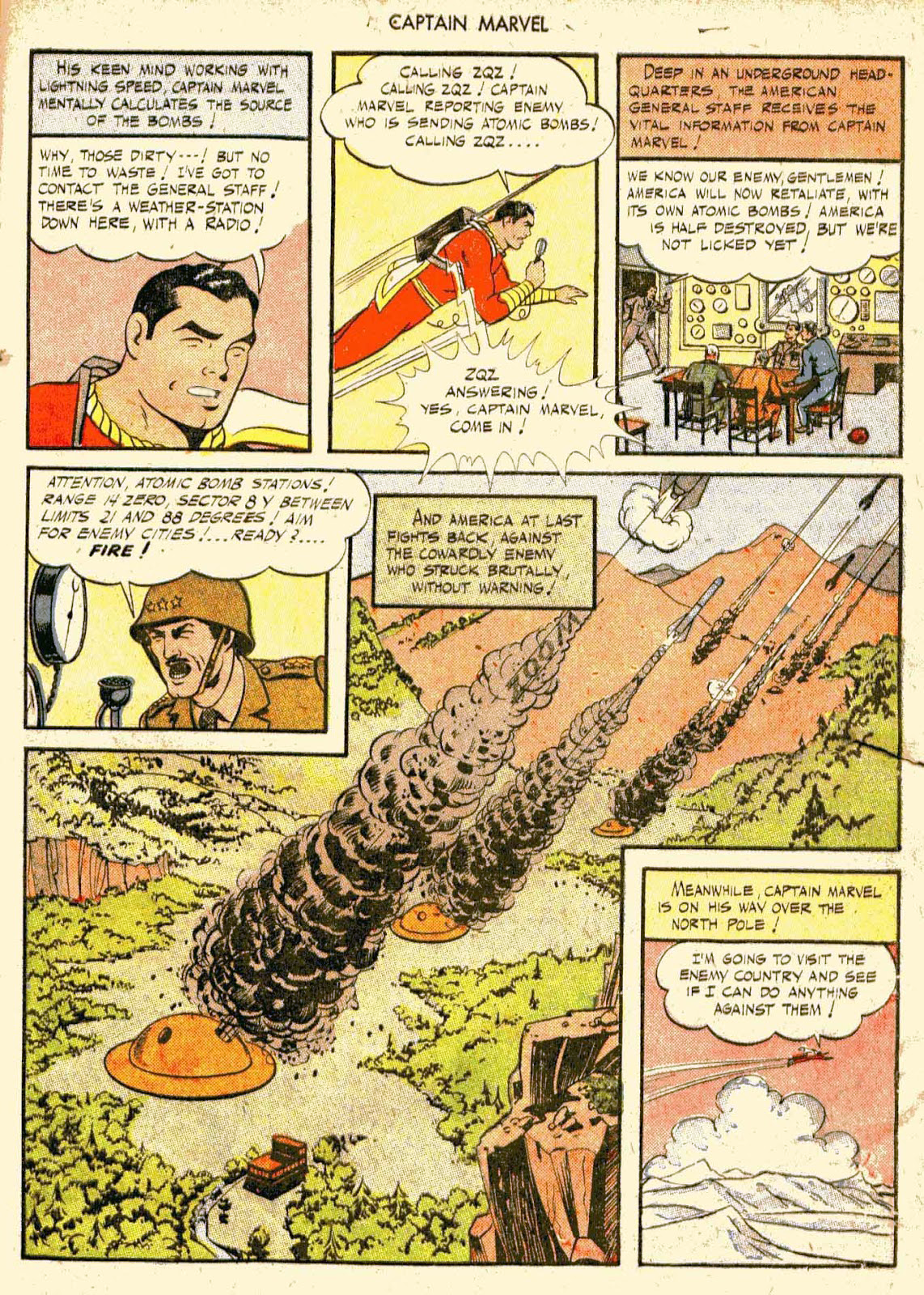
It continues to make sense that there would be a retaliatory strike depicted; Cap makes himself a weapon of the military, which is not exactly unheard of in Golden Age comics, but for him specifically seems especially screwed up. He heads in the direction he’s sure their foe is in, ready to try to put a stop to any more of this, but all within the same page, he discovers—
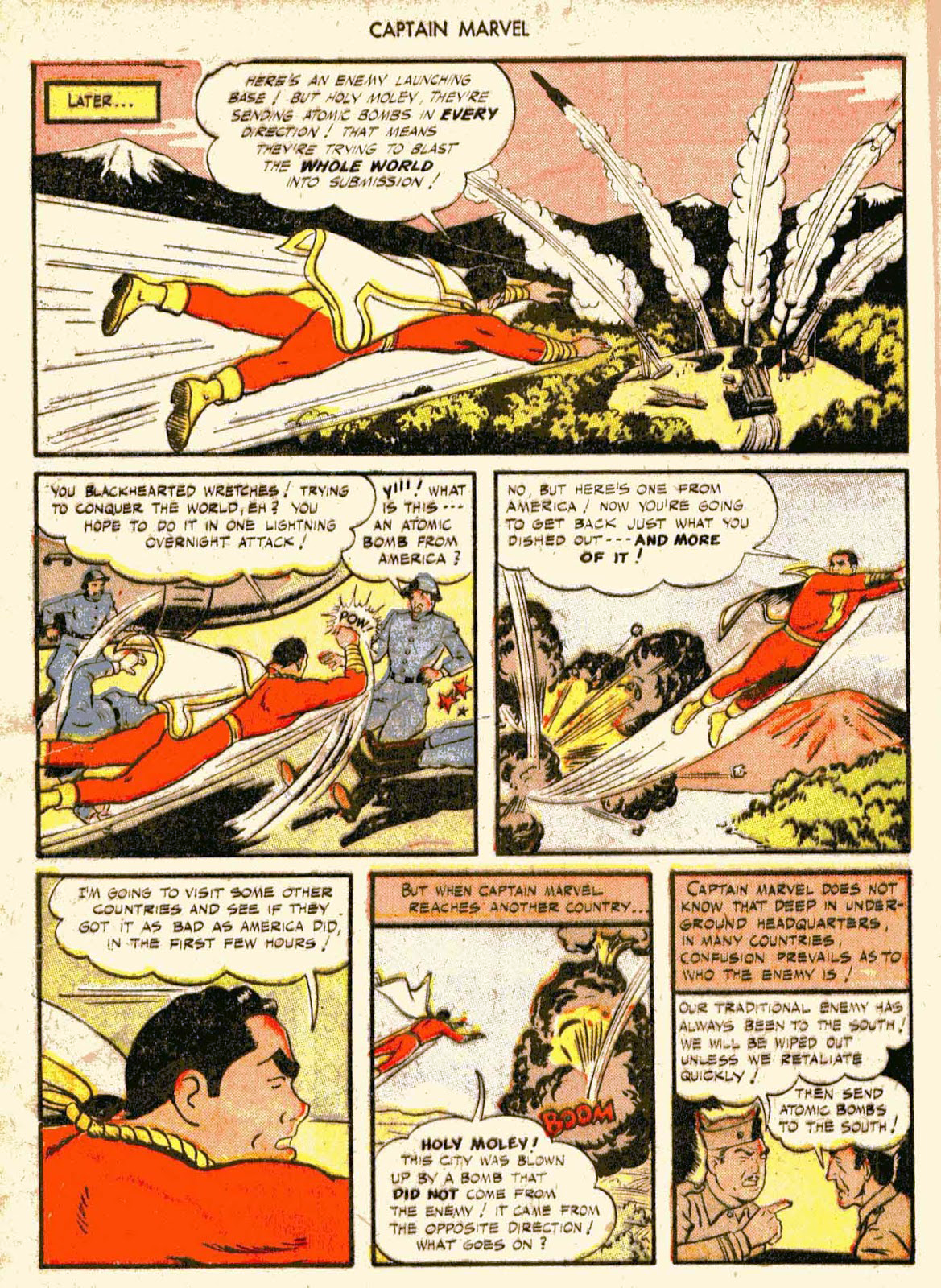
—it’s not as simple as that.
He doesn’t actually do any of the killing himself, though becoming the missile guidance system legitimately makes him a party to what will ultimately be total apocalyptic genocide. The telling thing here on this page is that it’s not a simple, neat solution: Cap found one enemy, but it turns out that said enemy isn’t the only culprit, not by a long shot.
What follows is, if you ask me, one of the better illustrations as to how there are no real ‘winners’ in a nuclear war. Instead of trying to pretend that the US ends up the triumphant victor — a little battered around the edges, but defiantly still in existence — Binder, Beck and Fawcett Comics put the pedal to the floor.
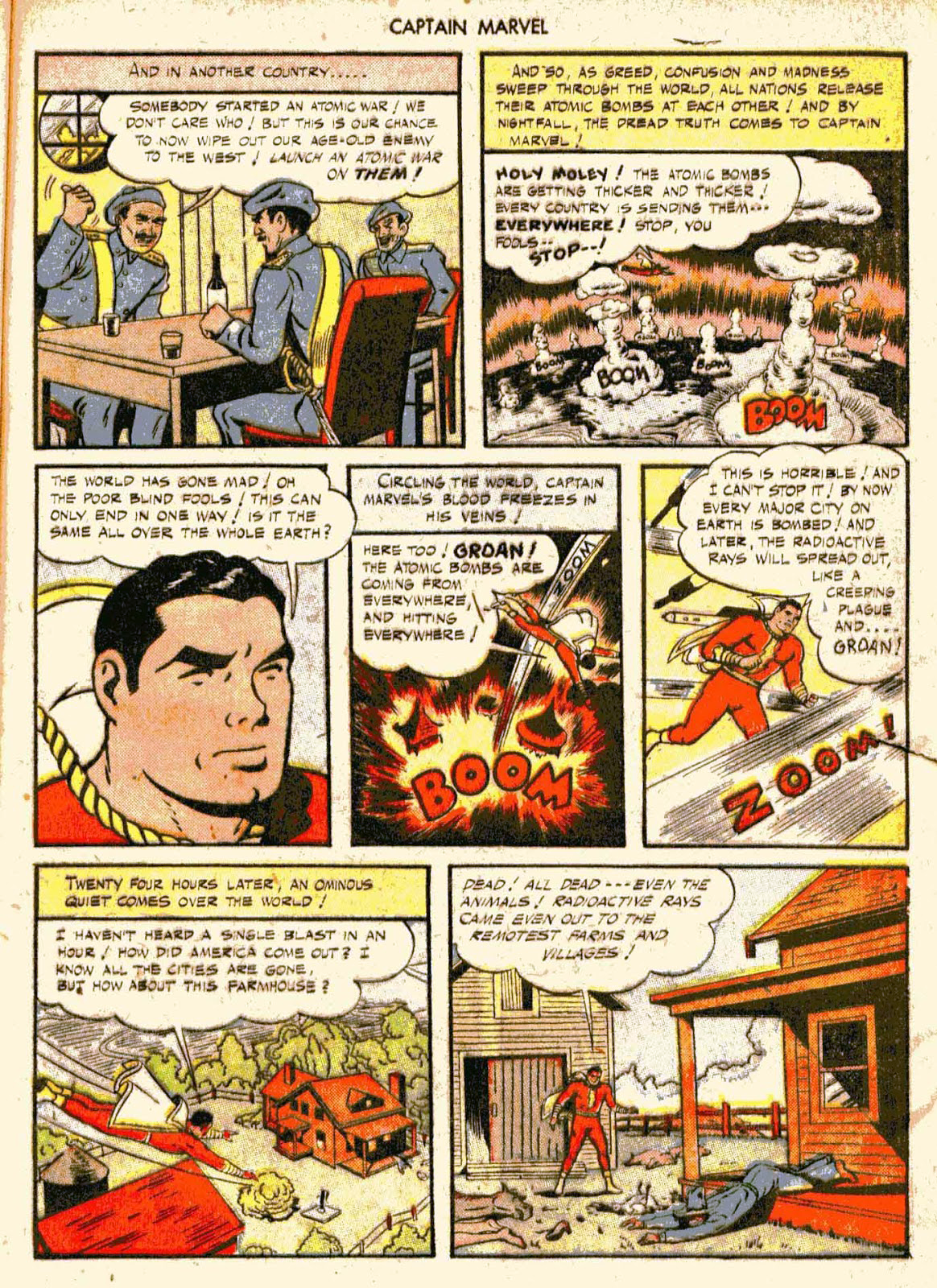
There’s no clean hero or villain — not even our hero, whose part was played in this catastrophe in him acting as a missile guidance system — and there’s no absolution for anyone here. At the end of the story, everyone’s dead. No one escaped — not human, not animal, not really even Cap himself — and if we probably know better now that likely even then, there would be survivors (for awhile), back then, it wasn’t quite so clear and even if it had been, that wasn’t really the point of how this story was told.
Just as it seems all possible hope has gone up in a mushroom cloud, we get one last page of this story:
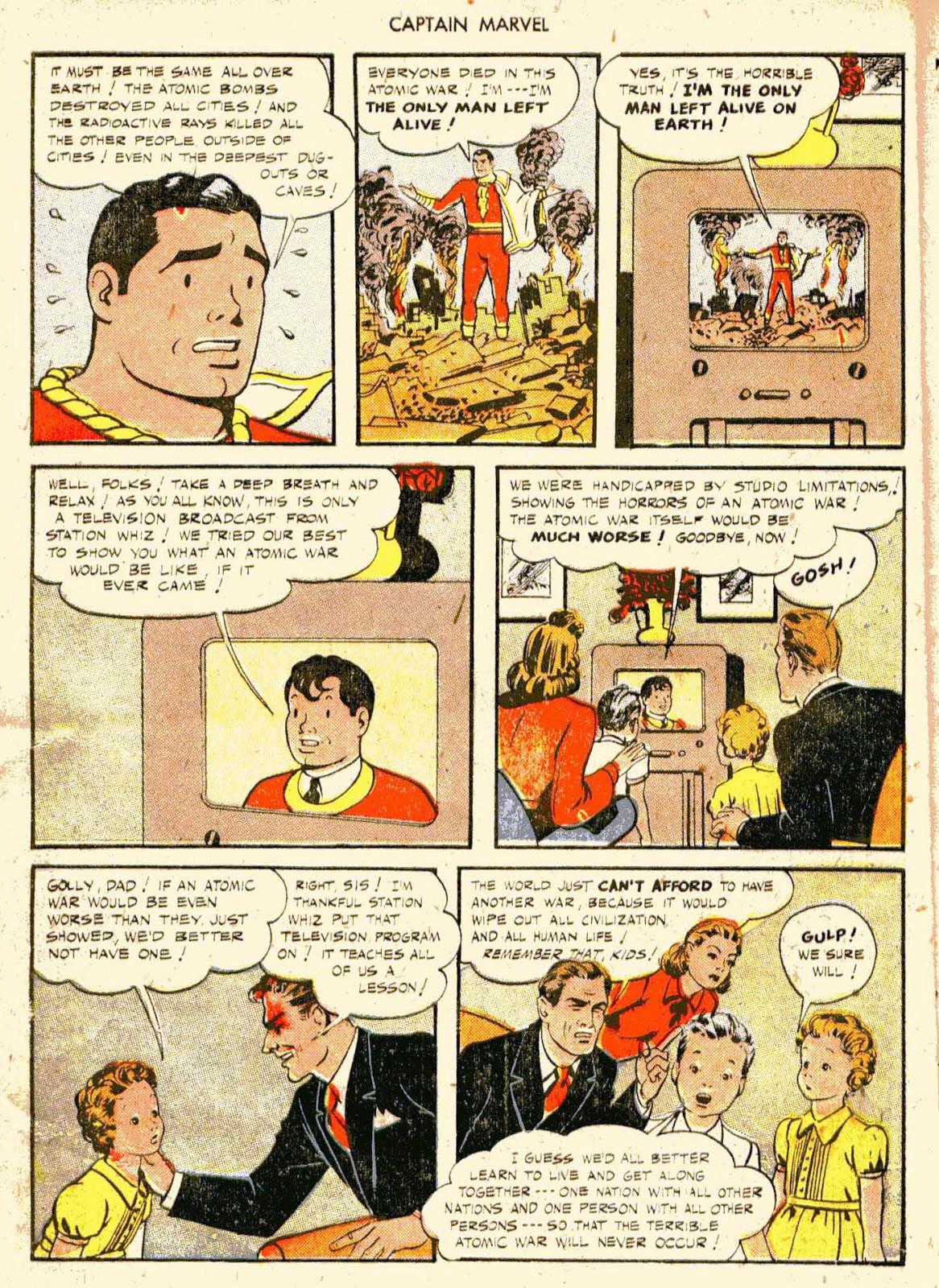
In the similar vein as to the trope ‘it was all just a dream,’ this one was all just a broadcast. (It was no doubt less of a cop-out and cliché back then!) Of all the pages in this story, this one’s the most comedic, though I’m pretty sure it wasn’t intended to be, and what humor is found in it is mostly in Billy’s signoff. (Kid, you just traumatized your entire viewing audience, do you really think a chipper ‘Goodbye now!’ is the best way to sign off the broadcast??)
The entire denouement, though, doesn’t scramble into patriotism. It also doesn’t excuse Cap’s involvement; by the end, even if he’s alive, he’s also paying for his part in perpetuating a nuclear war because he’s lost everyone he loved in a horrific manner. There’s no victory, just desolation. The story itself, from start to finish, doesn’t once flinch away from showing the pointlessness and horror of humanity self-destructing in that fashion, and the kids depicted here might be using a very heavy hand to get the point across, but they get it across nonetheless.
The rest of the issue returns to a lighthearted style, which is why I say this one has some serious tonal whiplash. But even for that whiplash and for the tone and content of this first story, it’s not a bad Captain Marvel tale; it being walked back as a broadcast at the end doesn’t change the fact that they depicted our hero as stunned sick, holding the hand of a dead mother, who in turn holds the body of her dead infant. Only at the end do you learn these are actors; at the time, you’re right along with Cap, heartsick and reeling, and this is the perfectly human reaction to being confronted with this kind of nightmare.
In the Power of Shazam! rehash of the Monster Society of Evil storyline, they nuke Fairfield off the map. A lot of people at the time complained bitterly that this somehow made the Marvel Family especially grimdark and was a completely unworthy storyline. Whatever that story’s flaws, though, this story shown here proves it’s not out of nowhere; that the Marvel Family is perfectly capable of facing up to something as devastating and awful as this. The bitter cries of it being somehow out of character to look at it in the nineties comes back to that fundamental misunderstanding of what was successful about the Golden Age Captain Marvel stories.
Billy was a pretty canny kid, and Cap was a pretty canny hero. Their whimsy was a product of good storytelling, and as I said before, not by treating the characters as somehow stupid. That was how Fawcett Comics could get away with the skinny-dipping in one issue and the nuclear holocaust in another. So when people now continue to insist on several things with the Marvel Family mythos, they’re often throwing darts blind and in the wrong direction.
What you don’t need is ‘Magical Superman’. Or ‘little boy in big man’s body’. Or ‘look how goofy and naive these characters are’. What you do need is to find the human heart of the Marvels; to remember that regardless of whether it’s whimsical or soulful, the story has got to be a human story, one we can relate to ourselves.
You won’t find that on the Rock of Eternity with magic flying in every corner. But you might just find it in Captain Marvel, knocked reeling, with his face in his hands because looking at it is, at least for moments, too much for him.
It’s not to say DC’s never done anything good with Cap and Billy. I liked Ordway’s series as an okay revamp of the mythos. I’ve loved several one-offs; Dini’s Power of Hope, for a really good example and one of the best modern day takes. Convergence: Shazam! and not only for the art by Doc Shaner. And people did sometimes handle Captain Marvel well even back in the 80s and 90s, as well. ↩
